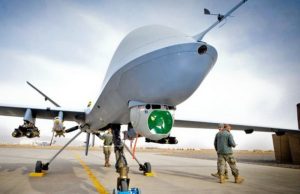Cameron looks to drones in the fight against Islamic State

By Professor David Galbreath
Note from PaCCS: This piece has been re-published with permission from Professor David Galbreath. It was first published on The Conversation UK website.
David Cameron has said that he is looking at potentially increasing the use of drones, spy planes and special forces in its fight against Islamic State. The prime minister says this equipment has become vital to “keeping us safe” and is now top of his defence shopping list. This just days after the UK agreed to invest 2% of GDP in defence, in line with NATO standards, for the rest of the decade.
For the UK, as for the US, special forces and unmanned aerial vehicles have become vital assets for dealing with insurgency in far-off lands. They defeat restrictions on space and time and offer flexibility and mobility, as has been seen in Afghanistan and Pakistan. These conflicts are reshaping how we think about armed intervention and how the UK will use kinetic force in the future.
The question now being asked is whether or not to use combat troops on the ground. It’s a conundrum for the UK, the US, France and others as they decide how to handle the ongoing crisis in Iraq and Syria. All of these states have opted for air war up until now, with minimal use of ground troops (except of course Iran, which has extensive forces involved in Iraq and Syria).
This makes sense in a conflict that is changing rapidly. Air power allows states to cover more space in shorter amounts of time – when of course they have air superiority as they do in Syria and Iraq. Traditional ground troops can’t provide this kind of flexibility.
Air power is also politically useful. A government staying off the ground can avoid appearing over-committed and minimise casualties. But at the same time, the US has been criticised for not providing a sustainable strategy for dealing with Islamic State. This stands in stark contrast to how NATO’s bombing in Yugoslavia was viewed in 1999. This campaign was seen as fundamental to bringing an end to Serbia’s military activity in Kosovo.
The key difference is that while NATO was fighting a traditional military in Yugoslavia, US-led action in Syria and Iraq is against an insurgency, similar to that seen in Afghanistan and at times Iraq during the Iraq War. A core component of counterinsurgency is being able to hold land by defending and building. Air power, in its current state, is not the best tool for holding land. This problem was evident in the Vietnam war and now in Afghanistan, Iraq and Syria.
Keeping up with the times
Cameron’s switch to drones and special operations can be seen as an alternative approach to counterinsurgency. UAVs provide militaries with the ability to extend themselves beyond traditional boundaries and remain present in hostile areas long after ground troops would have had to leave. They are even more manoeuvrable and cost effective than traditional aircraft. Some can remain in situ for more than a month without needing to be landed, charged or tended.
All this illustrates what we might assume would be the future armed intervention. On one hand, the wars in Afghanistan, Iraq and, before that, Vietnam illustrate that kinetic force is limited in its ability to bring about military and political solutions. On the other hand, Cameron’s statement suggests that he thinks his country’s security will be predicated on operational engagements with asymmetric forces for the foreseeable future.
Investing in drones may make sense for now, while the enemy is Islamic State. But militaries are likely to prepare for the wars they want to fight rather than those that are most likely to occur. Cameron should avoid throwing everything he has into drones. As we know, the nature of the enemy can change very quickly.
Professor David Galbreath is the Partnership’s Conflict Theme Leadership Fellow. He is a Professor of International Security at the University of Bath, focusing on the changing character of warfare through changes in science and technology. Professor Galbreath is also Director of the Centre for War and Technology and Editor-in-Chief of both European Security and Defence Studies.



